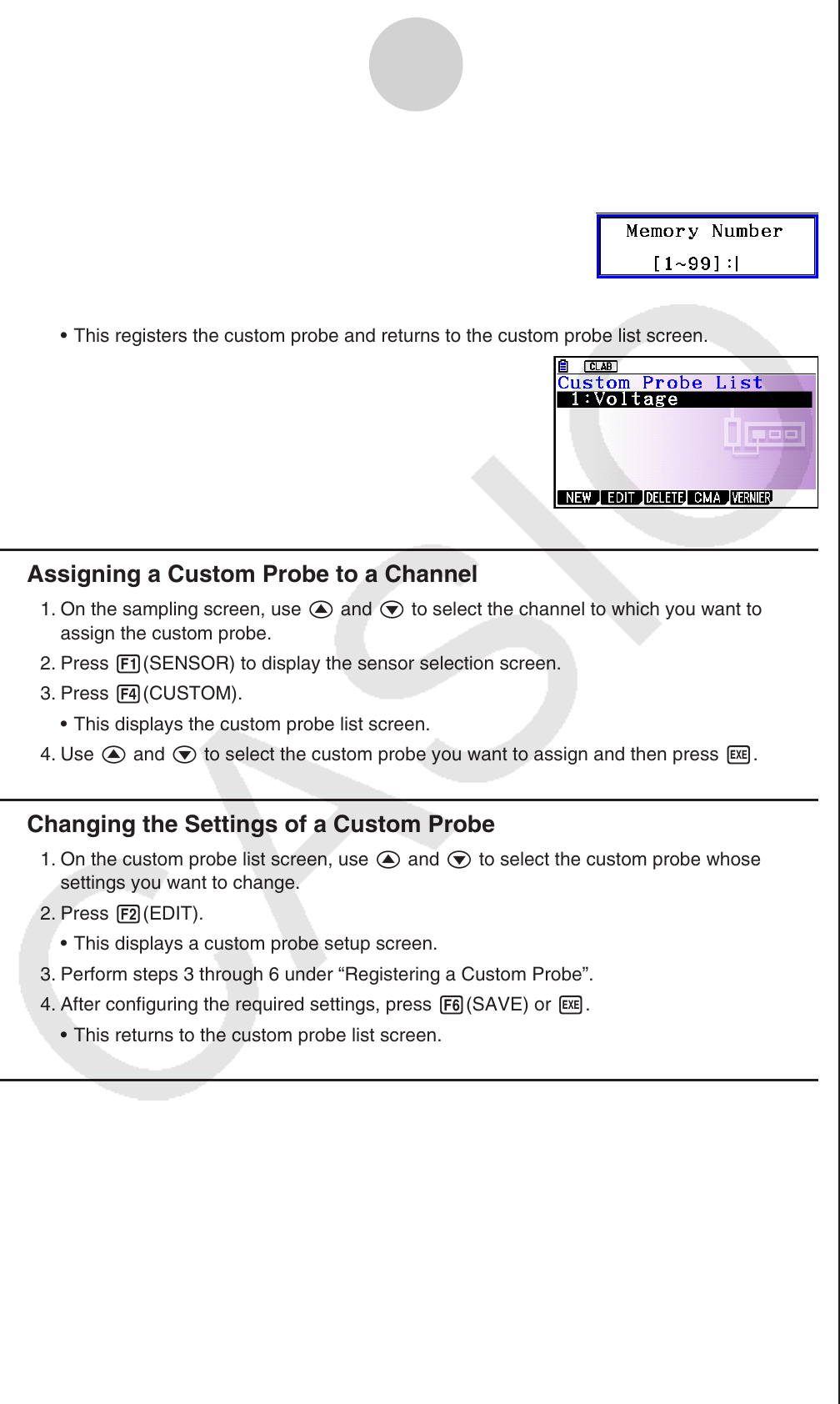User Manual
Table Of Contents
- Contents
- Getting Acquainted — Read This First!
- Chapter 1 Basic Operation
- Chapter 2 Manual Calculations
- 1. Basic Calculations
- 2. Special Functions
- 3. Specifying the Angle Unit and Display Format
- 4. Function Calculations
- 5. Numerical Calculations
- 6. Complex Number Calculations
- 7. Binary, Octal, Decimal, and Hexadecimal Calculations with Integers
- 8. Matrix Calculations
- 9. Vector Calculations
- 10. Metric Conversion Calculations
- Chapter 3 List Function
- Chapter 4 Equation Calculations
- Chapter 5 Graphing
- 1. Sample Graphs
- 2. Controlling What Appears on a Graph Screen
- 3. Drawing a Graph
- 4. Saving and Recalling Graph Screen Contents
- 5. Drawing Two Graphs on the Same Screen
- 6. Manual Graphing
- 7. Using Tables
- 8. Modifying a Graph
- 9. Dynamic Graphing
- 10. Graphing a Recursion Formula
- 11. Graphing a Conic Section
- 12. Drawing Dots, Lines, and Text on the Graph Screen (Sketch)
- 13. Function Analysis
- Chapter 6 Statistical Graphs and Calculations
- 1. Before Performing Statistical Calculations
- 2. Calculating and Graphing Single-Variable Statistical Data
- 3. Calculating and Graphing Paired-Variable Statistical Data (Curve Fitting)
- 4. Performing Statistical Calculations
- 5. Tests
- 6. Confidence Interval
- 7. Distribution
- 8. Input and Output Terms of Tests, Confidence Interval, and Distribution
- 9. Statistic Formula
- Chapter 7 Financial Calculation
- Chapter 8 Programming
- Chapter 9 Spreadsheet
- Chapter 10 eActivity
- Chapter 11 Memory Manager
- Chapter 12 System Manager
- Chapter 13 Data Communication
- Chapter 14 Geometry
- Chapter 15 Picture Plot
- Chapter 16 3D Graph Function
- Appendix
- Examination Mode
- E-CON4 Application (English)
- 1. E-CON4 Mode Overview
- 2. Sampling Screen
- 3. Auto Sensor Detection (CLAB Only)
- 4. Selecting a Sensor
- 5. Configuring the Sampling Setup
- 6. Performing Auto Sensor Calibration and Zero Adjustment
- 7. Using a Custom Probe
- 8. Using Setup Memory
- 9. Starting a Sampling Operation
- 10. Using Sample Data Memory
- 11. Using the Graph Analysis Tools to Graph Data
- 12. Graph Analysis Tool Graph Screen Operations
- 13. Calling E-CON4 Functions from an eActivity

ε-24
Using a Custom Probe
7. After configuring the required settings, press 6(SAVE) or w.
This displays the dialog box shown below.
8. Input the custom probe registration number (1 to 99) and then press w.
This registers the custom probe and returns to the custom probe list screen.
Assigning a Custom Probe to a Channel
1. On the sampling screen, use f and c to select the channel to which you want to
assign the custom probe.
2. Press 1(SENSOR) to display the sensor selection screen.
3. Press 4(CUSTOM).
This displays the custom probe list screen.
4. Use f and c to select the custom probe you want to assign and then press w.
Changing the Settings of a Custom Probe
1. On the custom probe list screen, use f and c to select the custom probe whose
settings you want to change.
2. Press 2(EDIT).
This displays a custom probe setup screen.
3. Perform steps 3 through 6 under “Registering a Custom Probe”.
4. After configuring the required settings, press 6(SAVE) or w.
This returns to the custom probe list screen.
Recalling CMA or Vernier Sensor Settings to Register a Custom Probe
1. On the custom probe list screen, press 4(CMA) or 5(VERNIER).
This displays a sensor list.
2. Use the f and c cursor keys to move the highlighting to the sensor whose settings you
want to use as the basis of the custom probe and then press w.
The name of the selected sensor and its setting information are shown on the custom
probe setup screen.
3. Perform steps 3 through 8 under “Registering a Custom Probe”. However, you will not be
able to change the sensor type.
•
•
k
•
k
•
•
k
•
•










